Abstract
In contrast to S. typhimurium [19], S. enteritidis is a serotype which has its primary food-animal reservoir in poultry. To date, phage typing has been of paramount importance in studying the epidemiology of this serotype and in particular, has demonstrated the involvement of both poultry meat and whole shell eggs in the transmission of S. enteritidis PT4 to humans. The findings discussed above describe various aspects of the serotype, particularly in relation to the involvement of both LPS and plasmids in its virulence and phage type identity (Fig. 2). These findings have led to an increased understanding of the biology of this serotype, which is of major importance in human food-poisoning in England and Wales at the present time.
Full text
PDF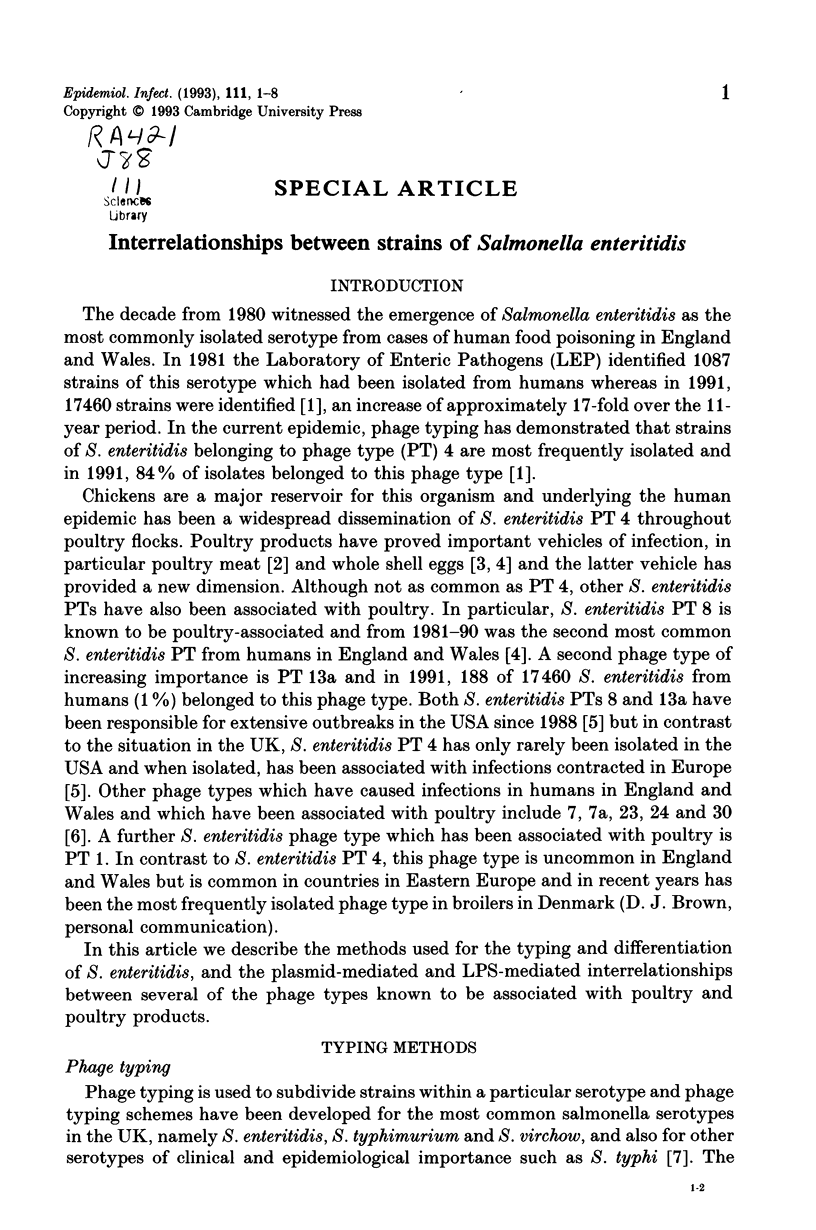
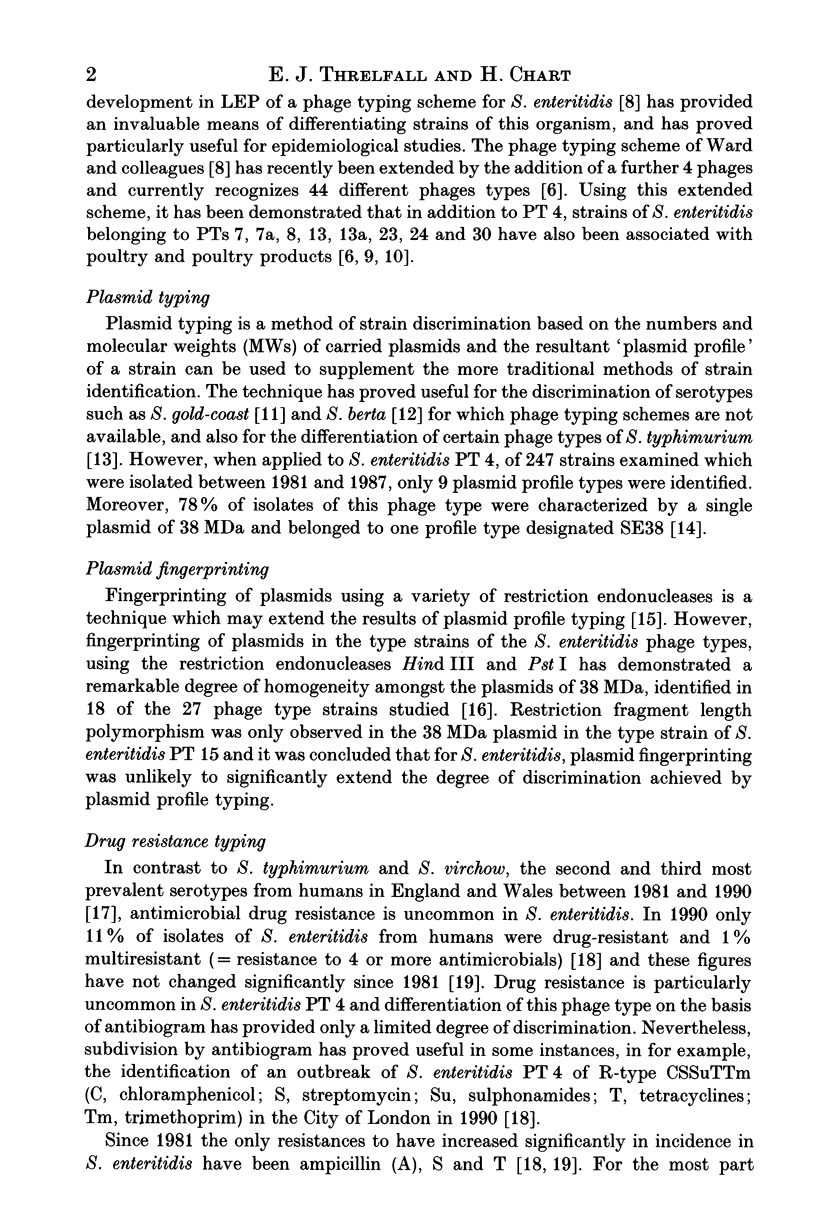
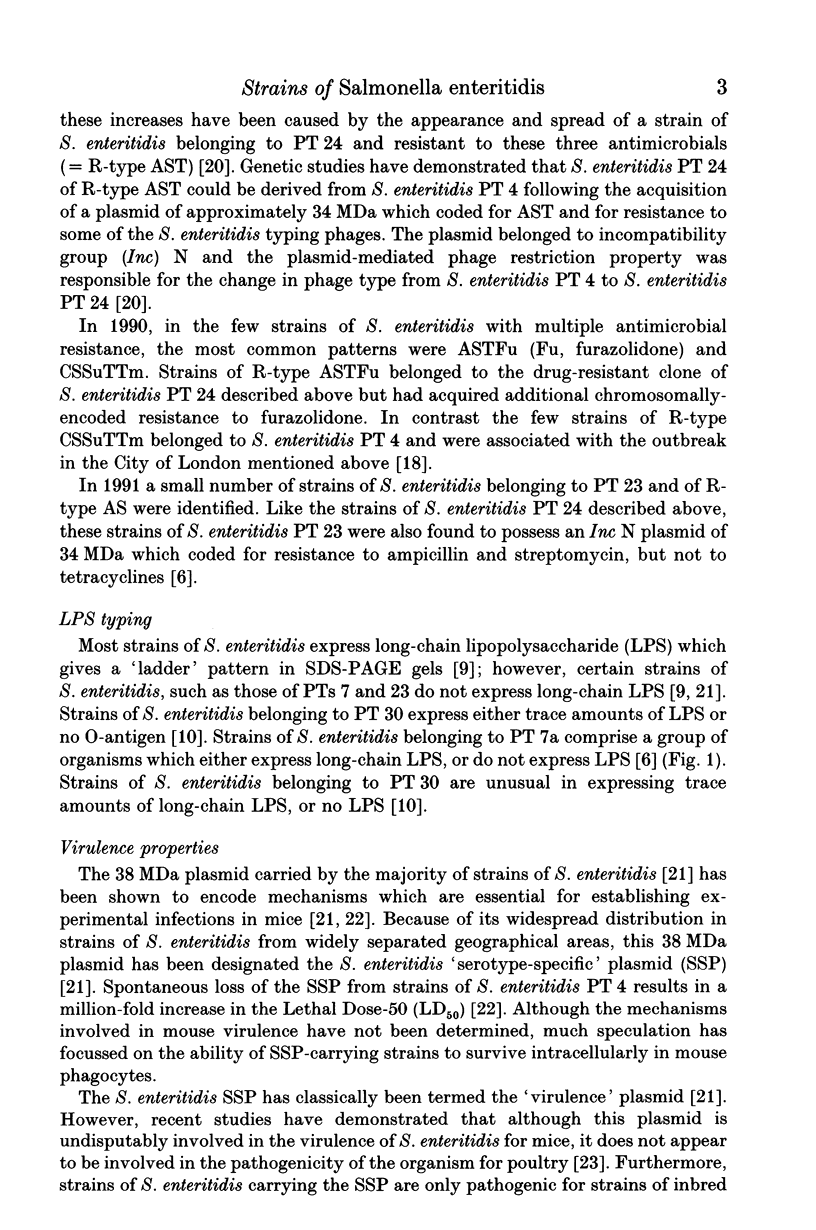
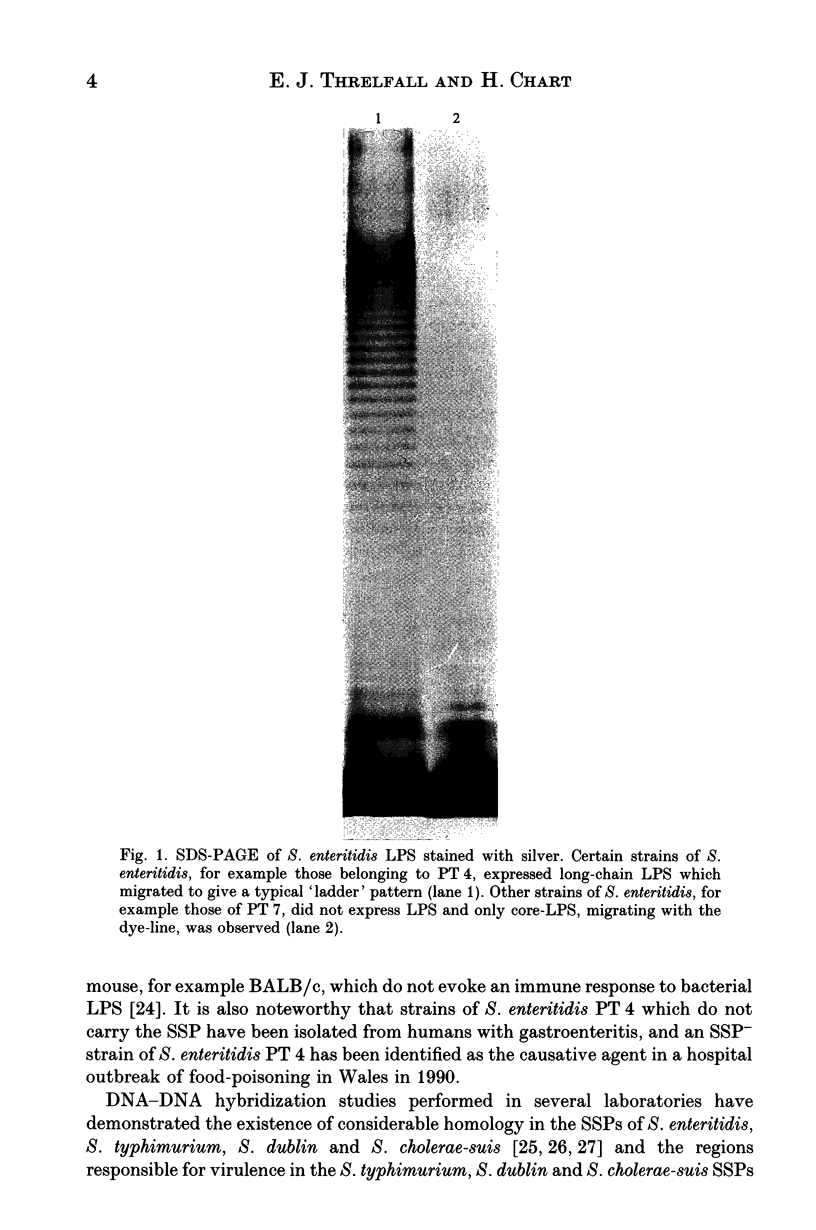
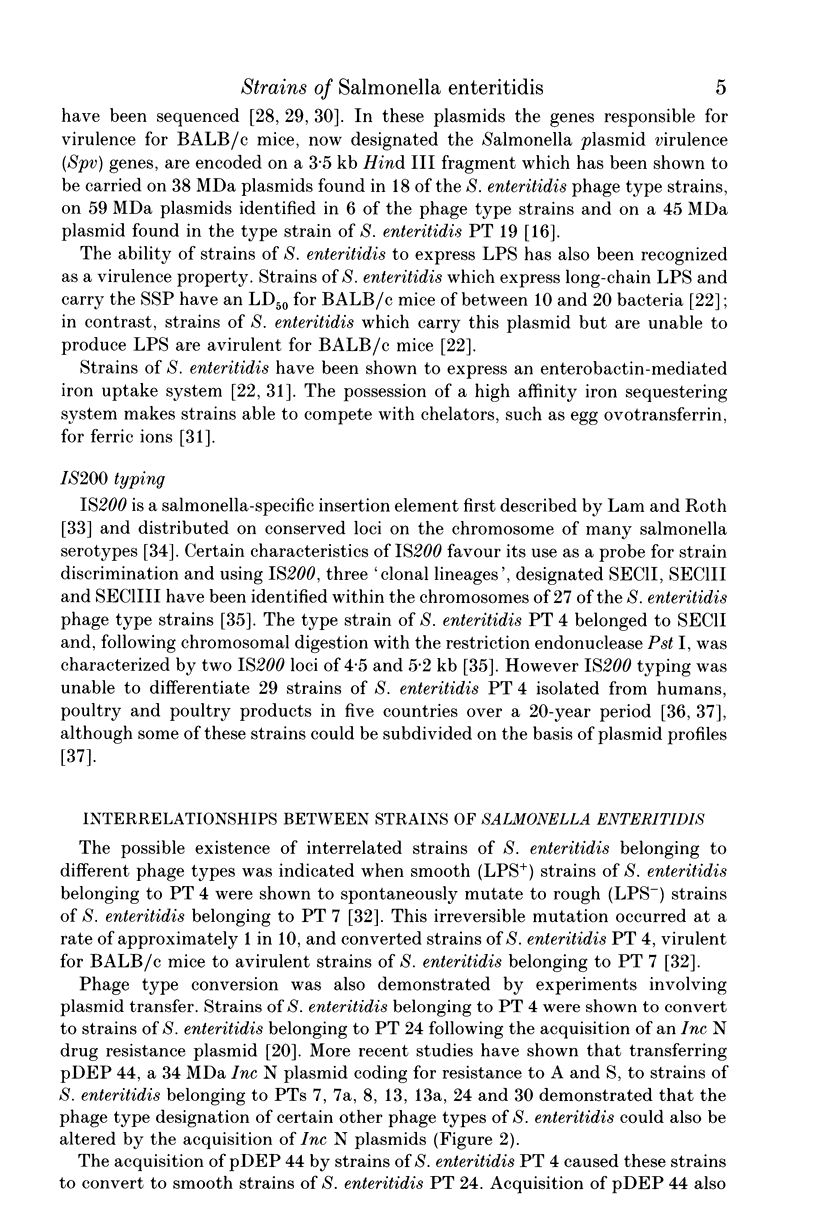
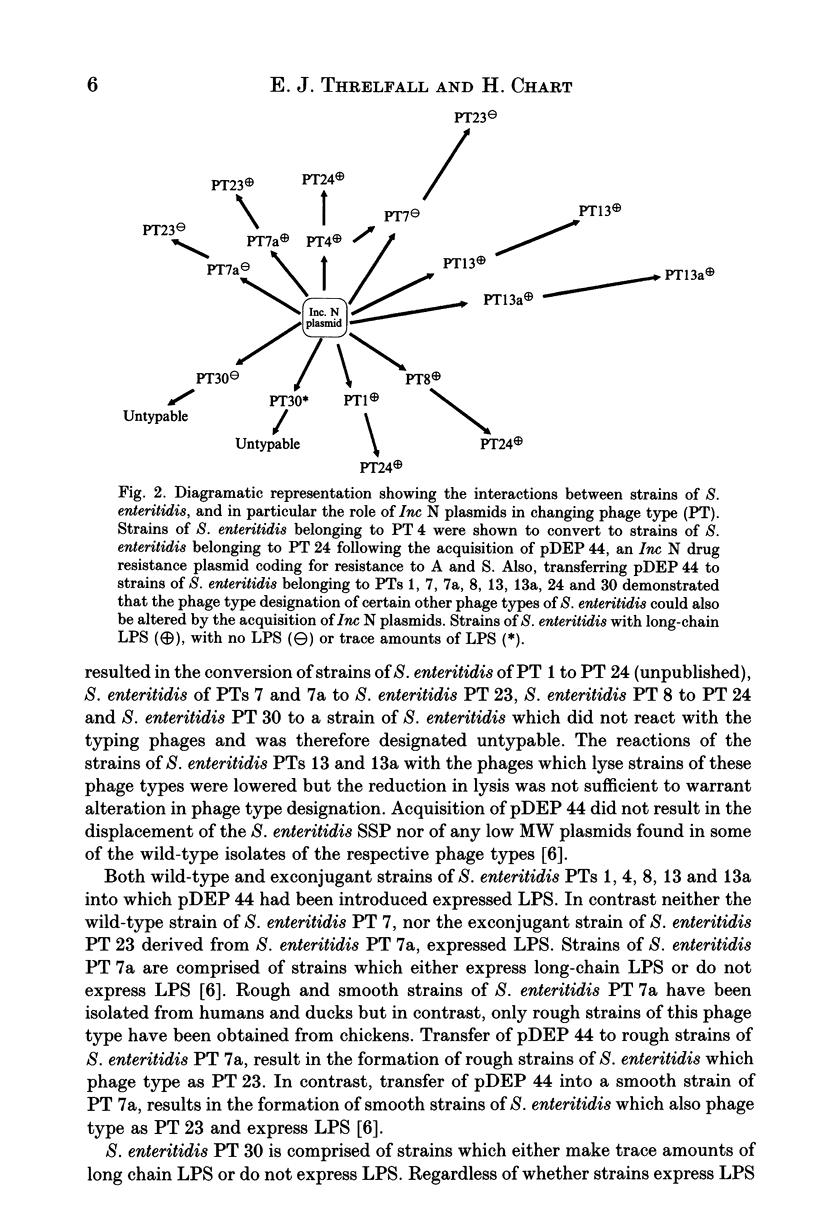
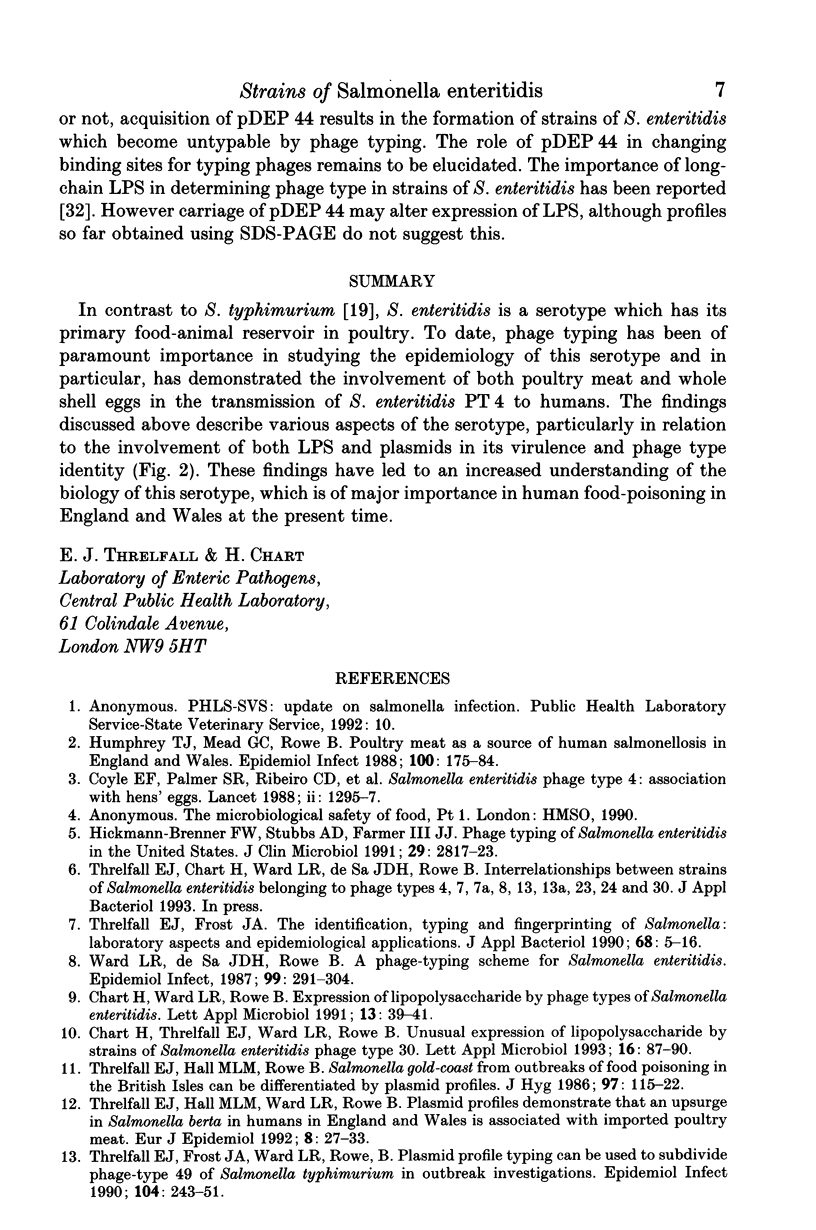
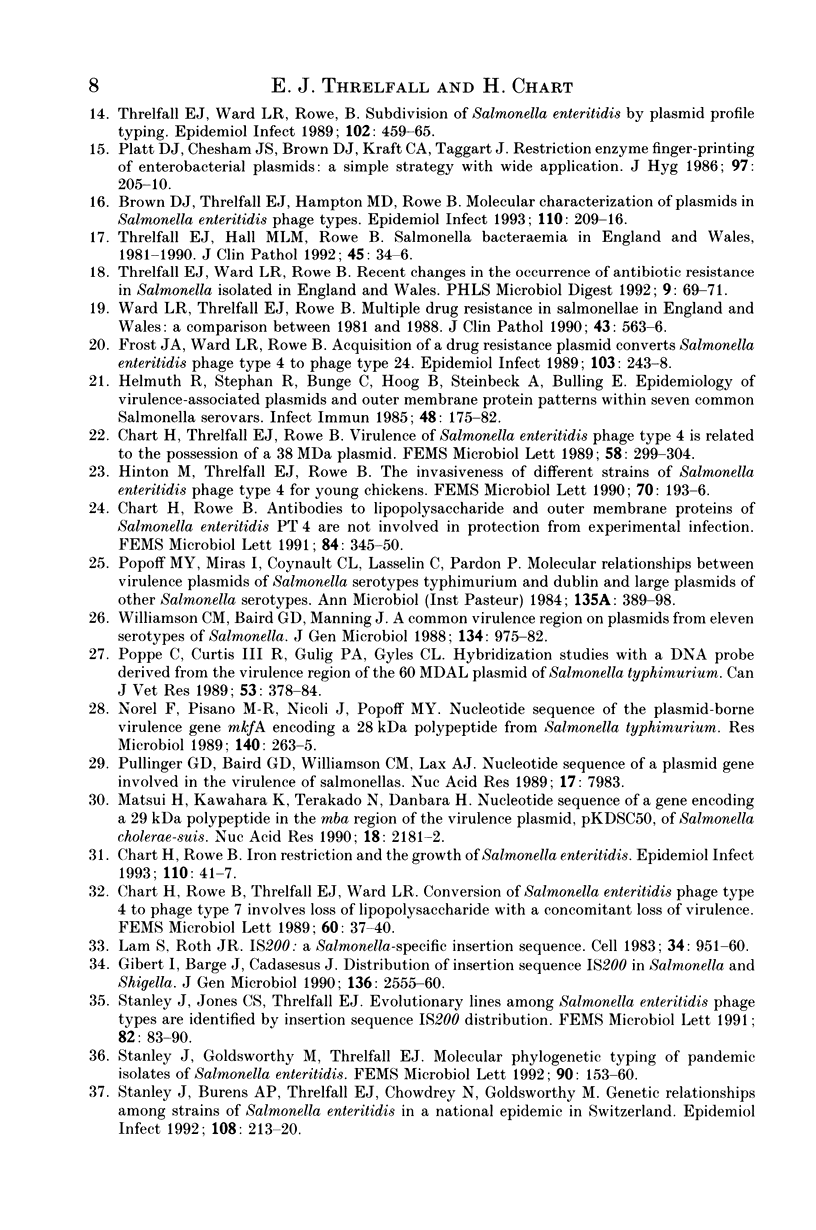
Images in this article
Selected References
These references are in PubMed. This may not be the complete list of references from this article.
- Brown D. J., Threlfall E. J., Hampton M. D., Rowe B. Molecular characterization of plasmids in Salmonella enteritidis phage types. Epidemiol Infect. 1993 Apr;110(2):209–216. doi: 10.1017/s0950268800068126. [DOI] [PMC free article] [PubMed] [Google Scholar]
- Chart H., Row B., Threlfall E. J., Ward L. R. Conversion of Salmonella enteritidis phage type 4 to phage type 7 involves loss of lipopolysaccharide with concomitant loss of virulence. FEMS Microbiol Lett. 1989 Jul 1;51(1):37–40. doi: 10.1016/0378-1097(89)90073-6. [DOI] [PubMed] [Google Scholar]
- Chart H., Rowe B. Antibodies to lipopolysaccharide and outer membrane proteins of Salmonella enteritidis PT4 are not involved in protection from experimental infection. FEMS Microbiol Lett. 1991 Dec 1;68(3):345–350. doi: 10.1016/0378-1097(91)90380-s. [DOI] [PubMed] [Google Scholar]
- Chart H., Rowe B. Iron restriction and the growth of Salmonella enteritidis. Epidemiol Infect. 1993 Feb;110(1):41–47. doi: 10.1017/s0950268800050664. [DOI] [PMC free article] [PubMed] [Google Scholar]
- Chart H., Threlfall E. J., Rowe B. Virulence of Salmonella enteritidis phage type 4 is related to the possession of a 38 MDa plasmid. FEMS Microbiol Lett. 1989 Apr;49(2-3):299–303. doi: 10.1016/0378-1097(89)90057-8. [DOI] [PubMed] [Google Scholar]
- Coyle E. F., Palmer S. R., Ribeiro C. D., Jones H. I., Howard A. J., Ward L., Rowe B. Salmonella enteritidis phage type 4 infection: association with hen's eggs. Lancet. 1988 Dec 3;2(8623):1295–1297. doi: 10.1016/s0140-6736(88)92902-9. [DOI] [PubMed] [Google Scholar]
- Frost J. A., Ward L. R., Rowe B. Acquisition of a drug resistance plasmid converts Salmonella enteritidis phage type 4 to phage type 24. Epidemiol Infect. 1989 Oct;103(2):243–248. doi: 10.1017/s0950268800030594. [DOI] [PMC free article] [PubMed] [Google Scholar]
- Gibert I., Barbé J., Casadesús J. Distribution of insertion sequence IS200 in Salmonella and Shigella. J Gen Microbiol. 1990 Dec;136(12):2555–2560. doi: 10.1099/00221287-136-12-2555. [DOI] [PubMed] [Google Scholar]
- Helmuth R., Stephan R., Bunge C., Hoog B., Steinbeck A., Bulling E. Epidemiology of virulence-associated plasmids and outer membrane protein patterns within seven common Salmonella serotypes. Infect Immun. 1985 Apr;48(1):175–182. doi: 10.1128/iai.48.1.175-182.1985. [DOI] [PMC free article] [PubMed] [Google Scholar]
- Hickman-Brenner F. W., Stubbs A. D., Farmer J. J., 3rd Phage typing of Salmonella enteritidis in the United States. J Clin Microbiol. 1991 Dec;29(12):2817–2823. doi: 10.1128/jcm.29.12.2817-2823.1991. [DOI] [PMC free article] [PubMed] [Google Scholar]
- Hinton M., Threlfall E. J., Rowe B. The invasiveness of different strains of Salmonella enteritidis phage type 4 for young chickens. FEMS Microbiol Lett. 1990 Jul;58(2):193–195. doi: 10.1111/j.1574-6968.1990.tb13977.x. [DOI] [PubMed] [Google Scholar]
- Humphrey T. J., Mead G. C., Rowe B. Poultry meat as a source of human salmonellosis in England and Wales. Epidemiological overview. Epidemiol Infect. 1988 Apr;100(2):175–184. doi: 10.1017/s0950268800067303. [DOI] [PMC free article] [PubMed] [Google Scholar]
- Lam S., Roth J. R. IS200: a Salmonella-specific insertion sequence. Cell. 1983 Oct;34(3):951–960. doi: 10.1016/0092-8674(83)90552-4. [DOI] [PubMed] [Google Scholar]
- Matsui H., Kawahara K., Terakado N., Danbara H. Nucleotide sequences of genes encoding 32 kDa and 70 kDa polypeptides in mba region of the virulence plasmid, pKDSc50, of Salmonella choleraesuis. Nucleic Acids Res. 1990 Apr 25;18(8):2181–2182. doi: 10.1093/nar/18.8.2181. [DOI] [PMC free article] [PubMed] [Google Scholar]
- Norel F., Pisano M. R., Nicoli J., Popoff M. Y. Nucleotide sequence of the plasmid-borne virulence gene mkfA encoding a 28 kDa polypeptide from Salmonella typhimurium. Res Microbiol. 1989 Mar-Apr;140(3):263–265. doi: 10.1016/0923-2508(89)90081-8. [DOI] [PubMed] [Google Scholar]
- Platt D. J., Chesham J. S., Brown D. J., Kraft C. A., Taggart J. Restriction enzyme fingerprinting of enterobacterial plasmids: a simple strategy with wide application. J Hyg (Lond) 1986 Oct;97(2):205–210. doi: 10.1017/s0022172400065281. [DOI] [PMC free article] [PubMed] [Google Scholar]
- Popoff M. Y., Miras I., Coynault C., Lasselin C., Pardon P. Molecular relationships between virulence plasmids of Salmonella serotypes typhimurium and dublin and large plasmids of other Salmonella serotypes. Ann Microbiol (Paris) 1984 May-Jun;135A(3):389–398. doi: 10.1016/s0769-2609(84)80080-0. [DOI] [PubMed] [Google Scholar]
- Poppe C., Curtiss R., 3rd, Gulig P. A., Gyles C. L. Hybridization studies with a DNA probe derived from the virulence region of the 60 Mdal plasmid of Salmonella typhimurium. Can J Vet Res. 1989 Oct;53(4):378–384. [PMC free article] [PubMed] [Google Scholar]
- Pullinger G. D., Baird G. D., Williamson C. M., Lax A. J. Nucleotide sequence of a plasmid gene involved in the virulence of salmonellas. Nucleic Acids Res. 1989 Oct 11;17(19):7983–7983. doi: 10.1093/nar/17.19.7983. [DOI] [PMC free article] [PubMed] [Google Scholar]
- Stanley J., Burnens A. P., Threlfall E. J., Chowdry N., Goldsworthy M. Genetic relationships among strains of Salmonella enteritidis in a national epidemic in Switzerland. Epidemiol Infect. 1992 Apr;108(2):213–220. doi: 10.1017/s0950268800049694. [DOI] [PMC free article] [PubMed] [Google Scholar]
- Stanley J., Goldsworthy M., Threlfall E. J. Molecular phylogenetic typing of pandemic isolates of Salmonella enteritidis. FEMS Microbiol Lett. 1992 Jan 1;69(2):153–160. doi: 10.1016/0378-1097(92)90620-4. [DOI] [PubMed] [Google Scholar]
- Stanley J., Jones C. S., Threlfall E. J. Evolutionary lines among Salmonella enteritidis phage types are identified by insertion sequence IS200 distribution. FEMS Microbiol Lett. 1991 Jul 15;66(1):83–89. doi: 10.1016/0378-1097(91)90425-a. [DOI] [PubMed] [Google Scholar]
- Threlfall E. J., Frost J. A. The identification, typing and fingerprinting of Salmonella: laboratory aspects and epidemiological applications. J Appl Bacteriol. 1990 Jan;68(1):5–16. doi: 10.1111/j.1365-2672.1990.tb02542.x. [DOI] [PubMed] [Google Scholar]
- Threlfall E. J., Frost J. A., Ward L. R., Rowe B. Plasmid profile typing can be used to subdivide phage-type 49 of Salmonella typhimurium in outbreak investigations. Epidemiol Infect. 1990 Apr;104(2):243–251. doi: 10.1017/s0950268800059410. [DOI] [PMC free article] [PubMed] [Google Scholar]
- Threlfall E. J., Hall M. L., Rowe B. Salmonella bacteraemia in England and Wales, 1981-1990. J Clin Pathol. 1992 Jan;45(1):34–36. doi: 10.1136/jcp.45.1.34. [DOI] [PMC free article] [PubMed] [Google Scholar]
- Threlfall E. J., Hall M. L., Rowe B. Salmonella gold-coast from outbreaks of food-poisoning in the British Isles can be differentiated by plasmid profiles. J Hyg (Lond) 1986 Aug;97(1):115–122. doi: 10.1017/s0022172400064408. [DOI] [PMC free article] [PubMed] [Google Scholar]
- Threlfall E. J., Hall M. L., Ward L. R., Rowe B. Plasmid profiles demonstrate that an upsurge in Salmonella berta in humans in England and Wales is associated with imported poultry meat. Eur J Epidemiol. 1992 Jan;8(1):27–33. doi: 10.1007/BF02427388. [DOI] [PubMed] [Google Scholar]
- Threlfall E. J., Rowe B., Ward L. R. Subdivision of Salmonella enteritidis phage types by plasmid profile typing. Epidemiol Infect. 1989 Jun;102(3):459–465. doi: 10.1017/s095026880003017x. [DOI] [PMC free article] [PubMed] [Google Scholar]
- Ward L. R., Threlfall E. J., Rowe B. Multiple drug resistance in salmonellae in England and Wales: a comparison between 1981 and 1988. J Clin Pathol. 1990 Jul;43(7):563–566. doi: 10.1136/jcp.43.7.563. [DOI] [PMC free article] [PubMed] [Google Scholar]
- Ward L. R., de Sa J. D., Rowe B. A phage-typing scheme for Salmonella enteritidis. Epidemiol Infect. 1987 Oct;99(2):291–294. doi: 10.1017/s0950268800067765. [DOI] [PMC free article] [PubMed] [Google Scholar]
- Williamson C. M., Baird G. D., Manning E. J. A common virulence region on plasmids from eleven serotypes of Salmonella. J Gen Microbiol. 1988 Apr;134(4):975–982. doi: 10.1099/00221287-134-4-975. [DOI] [PubMed] [Google Scholar]



